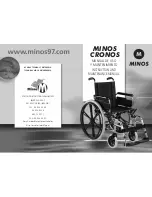
Easy Tilt 32
6.
The tie down restraint system should be fixed to the main frame of the wheelchair, where indicated by the manufacturer, under no circumstances
should it be fixed to wheelchair components or accessory parts, i.e. not to the spokes of the wheel, the brakes or the footrests.
7.
The tie down restraints should be attached as close as possible at an angle of 45° degrees and tightened securely in accordance with the
manufacturer's instructions.
8.
Alteration or substitution should not be made to the wheelchair securement points or to structural and frame parts or components without consulting
the manufacturer.
9.
To secure the wheelchair occupant and to reduce the risk of possible head and chest injury from impact with
vehicle components and potential consequential injuries for the wheelchair occupant and other vehicle occupants,
pelvic
(2)
and upper torso
(1)
belts must be used. (Fig. B). The upper torso belt must be fixed to the pillar of the
vehicle. If this advice is not closely followed it could lead to an increased risk of abdominal injuries to the wheelchair
occupant.
10.
A head restraint suitable for transportation must be available and fitted accordingly during transportation.
11.
Postural support should not be relied on for occupant restraint in a moving vehicle, unless they are labelled as
being in accordance with the requirements specified in ISO 7176-19:2008.
12.
Care should be taken when applying the occupant restraint to position the seatbelt buckle so that the release button
will not be contacted by wheelchair components during a crash.
13.
In order to reduce the potential of injury to vehicle occupants, wheelchair-mounted trays not specifically designed to
pass the crash test should be removed and secured separately in the vehicle or be secured to the wheelchair but
positioned away from the occupant with energy-absorbing padding placed between the tray and the occupant.
14.
During transportation of occupied wheelchair: in case of pivoted/elevating leg-rests, the latter should not be used in raised position; if the backrest is
of the “dynamically angle adjustable” type, it should be mov
ed to the upright
position. If the seat is of the “tilting” type, it should be moved to its
minimum inclination.
15.
The manual brakes must always be firmly engaged.
16.
Safety belts must be fixed to a pillar of the vehicle and must not be separated from the occup
ant’s body b
y wheelchair components or parts such as
armrests or wheels.
17.
When possible, other auxiliary wheelchair equipment should be either secured to the wheelchair or removed from the wheelchair and secured in the
vehicle during travel, so that it does not break free and cause injury to vehicle occupants in the event of collision.
FIG. B
1
2
Summary of Contents for EASY TILT
Page 1: ...ENGLISH rev 0 2021 05 User s manual TILTING WHEELCHAIR WITH RIGID FRAME EASY TILT...
Page 2: ...Easy Tilt 2...
Page 53: ...Easy Tilt 53...
Page 54: ...Easy Tilt 54...
Page 55: ...Easy Tilt 55...
















































